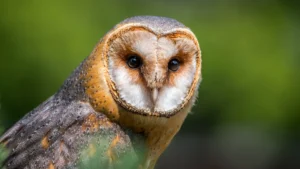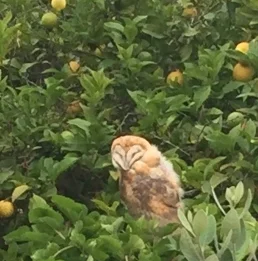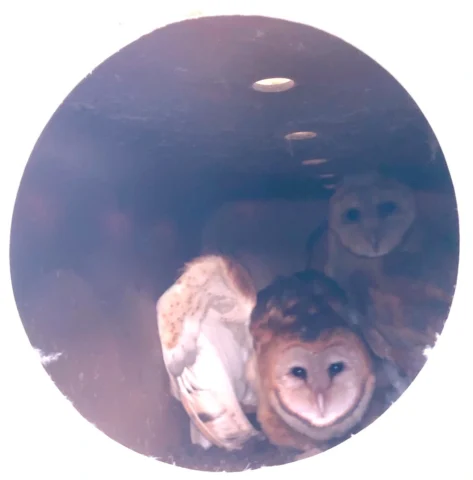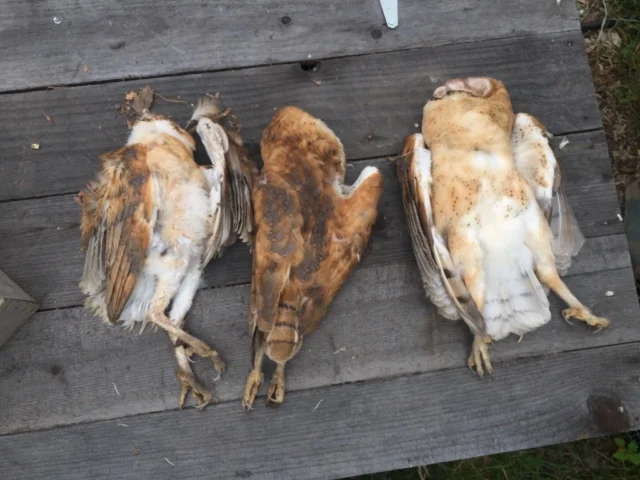Working With and Learning From Nature
Silent Night: The Unintended Consequences of Rodenticides

by Your Hungry Neighborhood Owl, as told to Jill Cloutier
You may see me after the sun goes down. A sharp, swift glide, feathers wide and silent, a blur of brown or white. You may hear me. My calls can fill the darkness with an otherworldly sound. I am your hungry neighborhood owl and I’m here to tell you a few things.
Many of us live with you including Barn Owls, Great Horned Owls, and Screech Owls. There are others in our family including Long Eared, CA Spotted, Northern Pygmy, Northern Saw Whet, and Flammulated. Short Eared and Burrowing Owls visit our area in the winter.
I am proud to be an owl. Not to boast, but we have silent flight, binocular vision, asymmetric ears, excellent hearing, and a full 270-degree head rotation. All of this contributes to our unparalleled effectiveness as rat and mice exterminators.
 Owl in Santa Barbara- Photo by Gary Milliken
Owl in Santa Barbara- Photo by Gary Milliken
Now I want to tell you my story. How many of you use rodenticides to get rid of rats? They may be sold to you as bait stations and come with a promise of no mess, low maintenance, and no fuss. You call an exterminator who places the stations around your property or business ad promises to be back to refill the stations quarterly. It’s easy!
Rats are drawn to the bait disguised as food and have a hearty meal, not knowing that they are eating anticoagulants like brodifacoum, bromadiolone, difenacoum, and difethialone. These second generation anticoagulants are not sold to consumers, but licensed exterminators can legally use them.
After visiting your station, rats become full of anticoagulants and either leave the area or continue to feed so long as the station contains “food.” Although these poisons are toxic to rats in a single feeding, a rat may not die immediately and can stay alive for days. How do they eventually die? Anticoagulants prevent the rat’s blood from clotting and cause it to die of internal hemorrhaging. If you’ve ever seen a rat stumbling down the street in the daytime, chances are they have been poisoned. As the rat grows weaker, they are easily caught by other animals. Where the poisoned rat ends up is a story of unintended consequences.
The rodenticide from your bait station enters the food chain when animals eat poisoned rodents and receive secondary exposure. They in turn, may be eaten by larger creatures. When owls and other animals see a rat who is easy prey, we eat it or take it home to our young. Thousands of predatory and scavenging animals become ill and die from a poison you didn’t intend for us to ingest. The impacts of these toxins are devastating to wildlife. We know you don’t mean to kill us, but when you use rodenticides, you very well could be. 
Life in an Owl Box- photo by Jeremy Crail
Rodenticide ingestion can lead to immune suppression in animals , including rodenticide-induced mange, nose bleeds, bleeding gums, bruising, bleeding into body cavities, blood in urine and feces, internal hemorrhaging, and death.
Over 29 species of animals test positive for rodenticide exposure in California. Animals affected include owls, hawks, eagles, vultures, condors, bobcats, mountain lions, skunks, coyotes, condors, black bears, and fish. We are the so-called non-target wildlife.
In the Santa Monica Mountains 92% of bobcats, 83% of coyotes, and 94% of mountain lions tested were exposed to anticoagulant poisons. Of 105 bobcats tested, more than 70 died from rodenticides. Twenty-one mountain lions out of twenty-two were exposed, with four dying from these poisons. If animals survive rodenticide poisoning, treatment is costly and time consuming and can take months to complete.
The CA Fish and Game says the reported number of non-target animals killed and injured each year by rodenticide is probably low, since many retreat to dens and burrows or other hiding places when they are in the throes of anticoagulant poisoning. Just like you might want to be home when you’re not feeling well.
For those of you with pets or children, rodenticides should be a concern. Thousands of children and domestic animals each year are poisoned by these chemicals. What’s more, rodenticides are now being detected in soil and water.
When a population of rats grows out of control, it signifies a lack of predators. The irony is that when you use rodenticides, you are adversely affecting predator populations: killing or poisoning the very animals who keep rodent populations down.
Owls from the Owl Box After Eating Rodenticide-Poisoned Rats- Photo by Jeremy Crail
The great news is that there are alternatives to rodenticides. You can be a good neighbor to wildlife and also manage rodent populations. Nontoxic methods of control include exclusion and sanitation. You can cut off access to your home by sealing up crevices and covering holes with chicken wire. Remove tree limbs that are three feet or closer to your roof. Clean up excess yard debris and fallen fruit. Trim ivy and other plants that rodents live in. Secure your trash bins. Don’t leave pet food outside. You can hire an abatement specialist who doesn’t use poisons. Trapping also works using electronic, live, or traditional snap traps. Don’t use glue traps, small birds and other animals can get stuck in them.
Instead of hiring a pest control operator who uses poisons, you need someone who can handle the issue for you with little effort on your part and no harmful effects on the environment, pets, children, soil, water, and surrounding wildlife.
Meet me! Your hungry neighborhood owl. I am a skillful hunter and voracious eater who works for free. A Barn Owl like me spends about a third of my life hunting! A pair of owls with chicks can eat up to 3,000 rodents a year.
How can you make your yard more appealing to predators like me? Put up an owl box. You can find plans online or buy one already made. Many wineries in California are using owls for rat patrol by giving us places to live onsite.
Hiring owls as your exterminators will result in a cleaner, less toxic world for all creatures and poison-free rats for wildlife. When you allow nature to solve your rodent problem, it’s cheaper and healthier for you, too.
You may not realize it yet, but if you keep using toxins like rodenticides, pesticides, and herbicides, your world will soon be a much lonelier place. Some time in the near future, you may find yourself sitting outside on a lovely summer evening. At first, you may not notice the silence. No hoots, no screeches, no coyote howls, no rustling sounds of opossums, skunks, and raccoons. You’ll only hear silence. A silent night.
Help us help you. Choose nature, not toxins.
Note: Since this article was written, the California Legislature passed AB-1788 The California Ecosystems Protection Act that prohibits the use of four second generation anticoagluants—brodifacoum, bromadiolone, difenacoum, and difethialone in California,- with some exemptions. This is not a total ban, but a moratorium until the Department of Pesticide Regulation completes a SGAR reevaluation study.
However, second generation anticoagulants are still being used in other states in the US and worldwide.
Pingback: Raptors and Rodenticides- the Unintended Consequences of Rat Poison | Sustainable World Radio